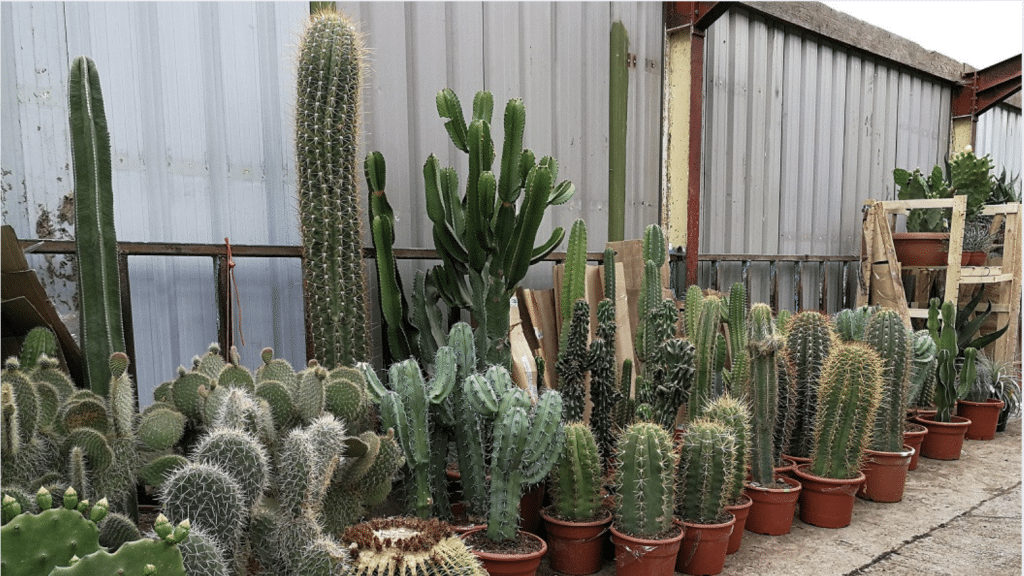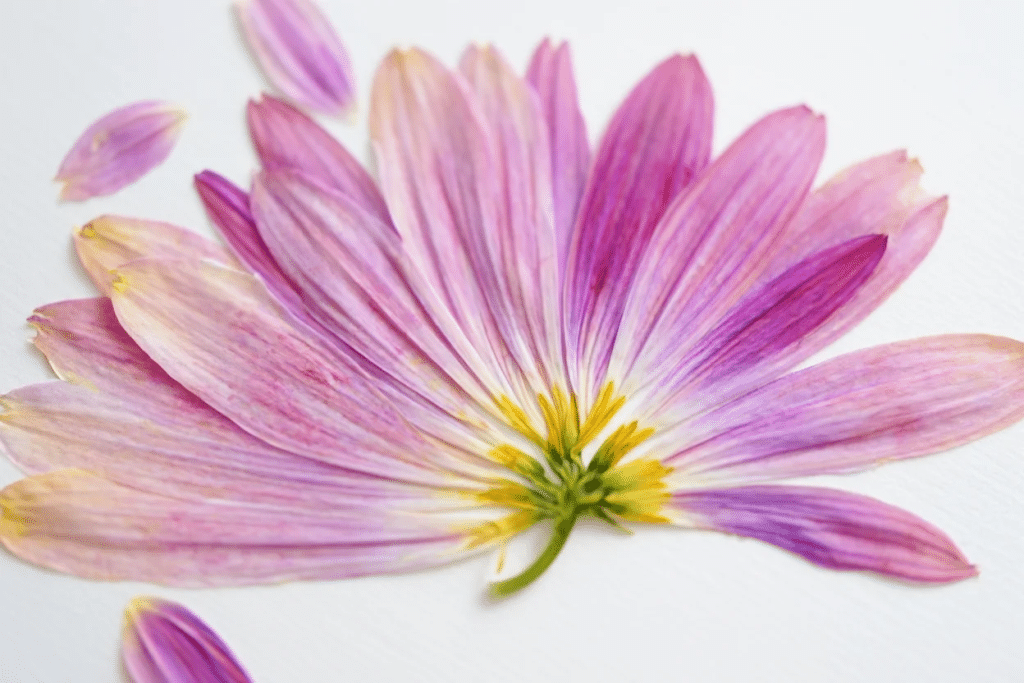More gardeners today want plants that look striking but need little care. Outdoor cactus varieties offer exactly that – bold shapes and textures that survive harsh weather while adding visual interest to any space.
Here you will know about the best outdoor cactus types for your garden, where to place them for maximum impact, and how they change through the seasons.
You’ll learn which varieties work in different climates and get practical tips for creating a low-maintenance garden that impresses year-round.
When and How to Plant Outdoor Cactus
Always plant the outdoor cactus in late spring or early fall. Spring gives them time to establish before summer heat hits. Fall planting works great too, since cooler weather reduces transplant shock and roots develop without stress.
How to Plant:
Start by choosing a location with excellent drainage and full sun exposure for at least 6-8 hours daily. Cacti hate wet feet, so avoid low-lying areas where water collects after rain.
Prepare the planting area by digging a hole twice as wide as the root ball but only as deep as the container.
Mix native soil with coarse sand, perlite, or gravel to improve drainage. A 50-50 mixture works well for most desert cacti.
Remove the cactus from its container carefully, using thick gloves or tongs to protect yourself from spines. Gently loosen any circled roots and place the plant at the same depth it was growing in the pot.
Backfill with your amended soil mixture and water lightly to settle the soil. Add a layer of gravel mulch around the base to prevent moisture from touching the stem and provide an attractive finish.
List of Outdoor Cacti You Should Know About
From towering columnar giants like the saguaro and cardón to compact globular types and sprawling prickly pears.
The following outdoor cacti offer striking architectural interest and adaptability for gardens in hot, dry, and even occasionally frosty climates.
1. Saguaro (Carnegiea Gigantea)
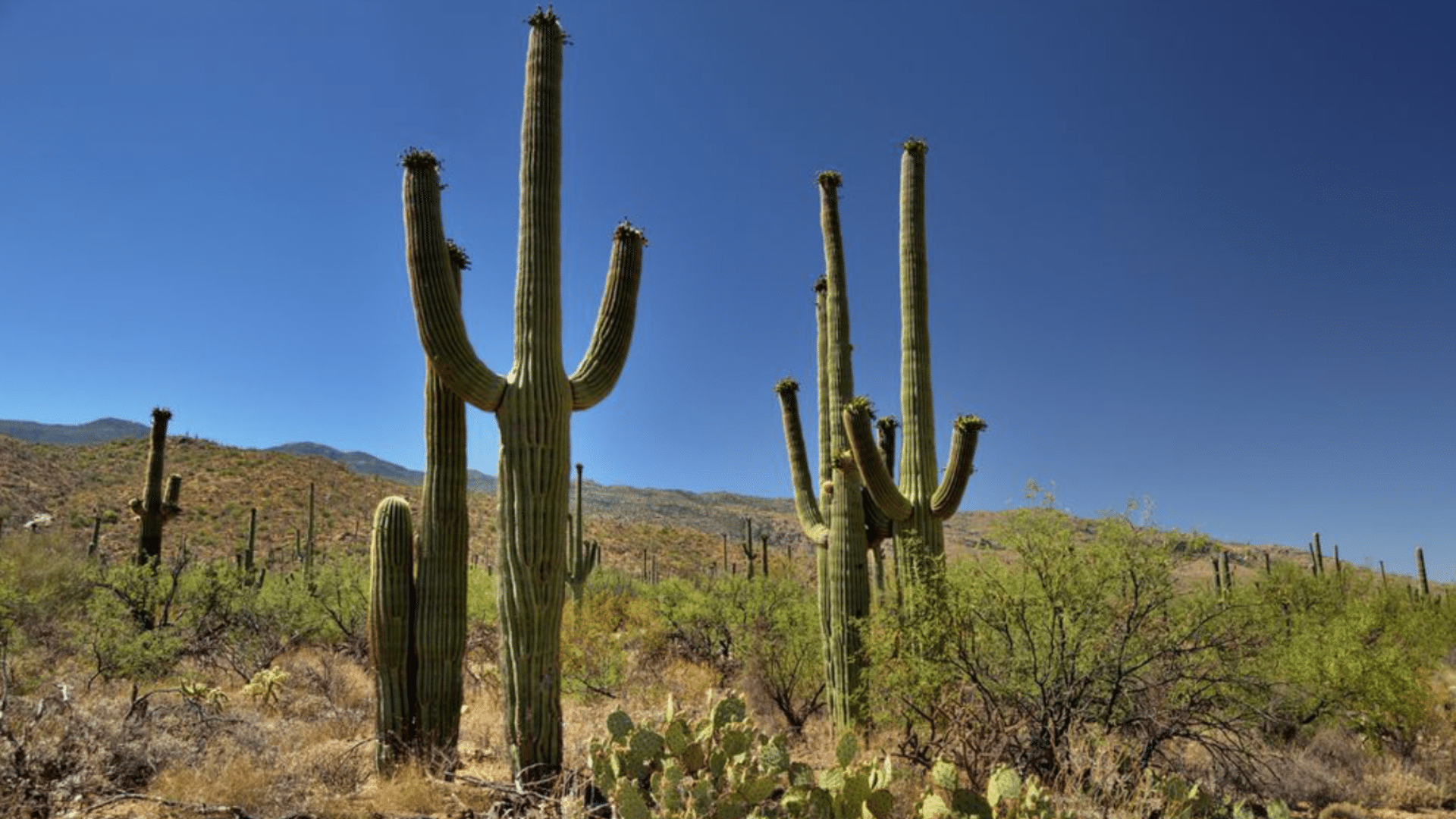
The Saguaro cactus (Carnegiea gigantea) is an iconic giant native to the Sonoran Desert, primarily found in southern Arizona and western Sonora, Mexico. These towering cacti can reach heights of up to 40 feet and live for over 150 years.
They grow very slowly and thrive in extremely hot, dry climates with minimal frost, requiring winter temperatures above 20°F. Their slow growth and longevity make them a defining feature of desert landscapes.
2. Mexican Fence Post (Pachycereus Marginatus)
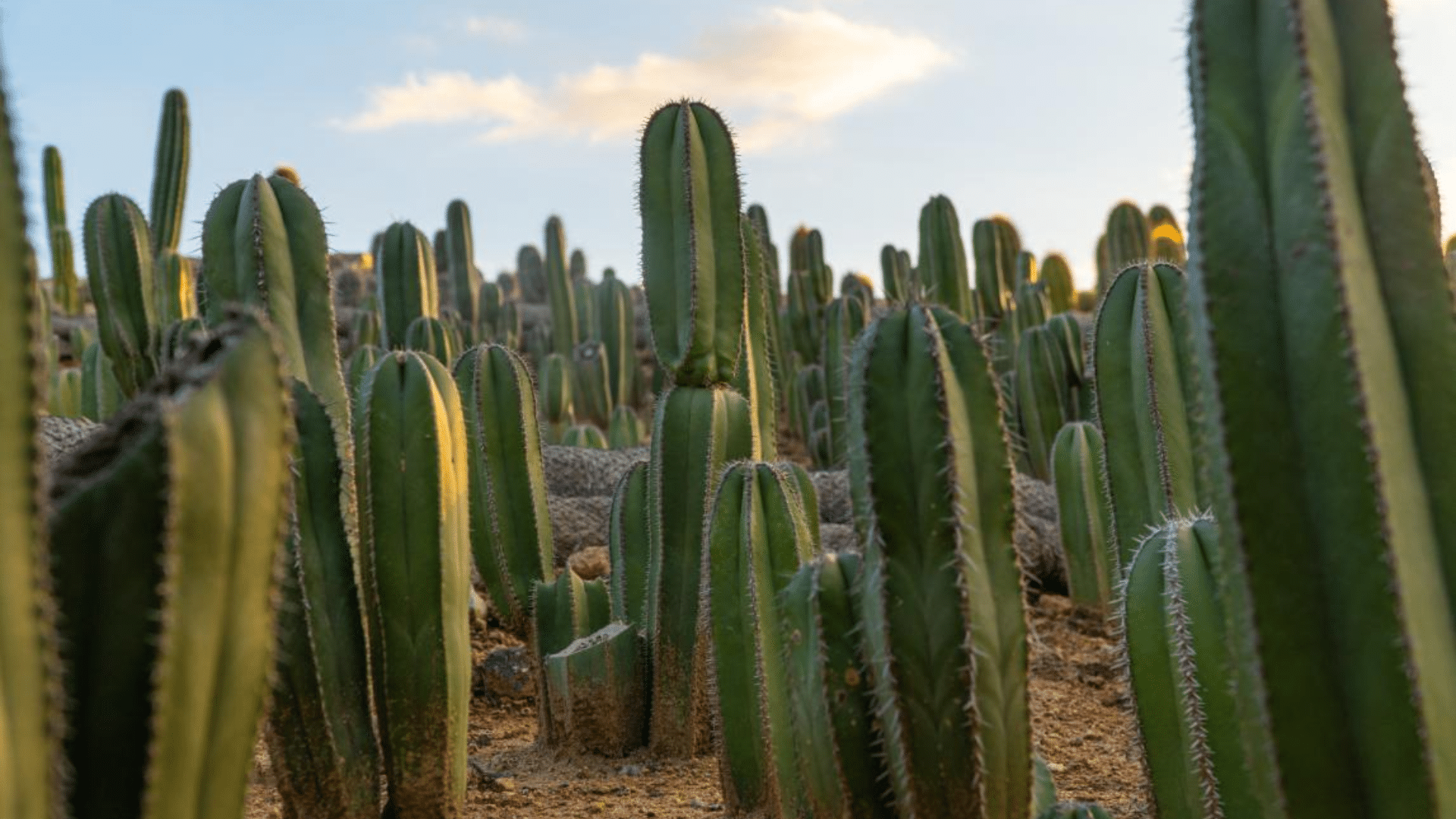
The Mexican Fence Post (Pachycereus marginatus) is a tall, columnar cactus native to central Mexico, often used as a living fence due to its upright, clustered stems.
Mature plants typically reach 10–15 feet in cultivation, though they can grow taller in their natural habitat. This cactus thrives in full sun and well-draining soil, tolerating drought and mild frost down to about 25°F.
Its ribbed, deep green stems are lined with short, stout spines, and in spring, it produces pink to red flowers followed by edible, spiny red fruit
3. Organ Pipe Cactus (Stenocereus thurberi)
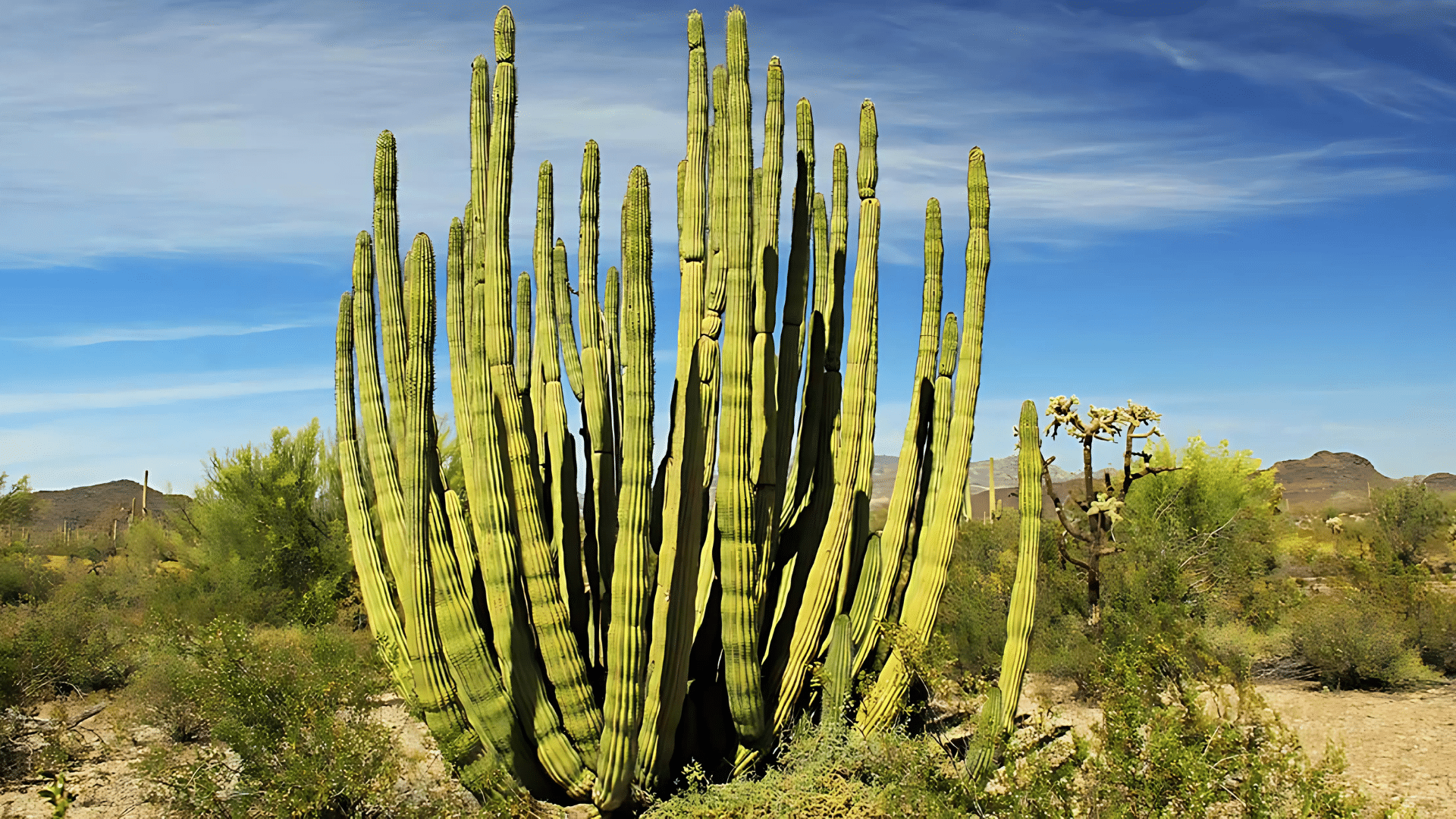
The Organ Pipe Cactus (Stenocereus thurberi) is a striking desert plant known for its tall, clustered stems that resemble the pipes of a church organ.
Native to the Sonoran Desert, it can reach up to 26 feet in height and is well adapted to arid, warm climates. This cactus thrives in full sun, prefers temperatures between 70°F and 100°F, and can tolerate brief drops to 20°F, though it is not frost-hardy.
It requires well-draining, sandy or rocky soil and low humidity to flourish
4. Myrtillocactus Geometrizans
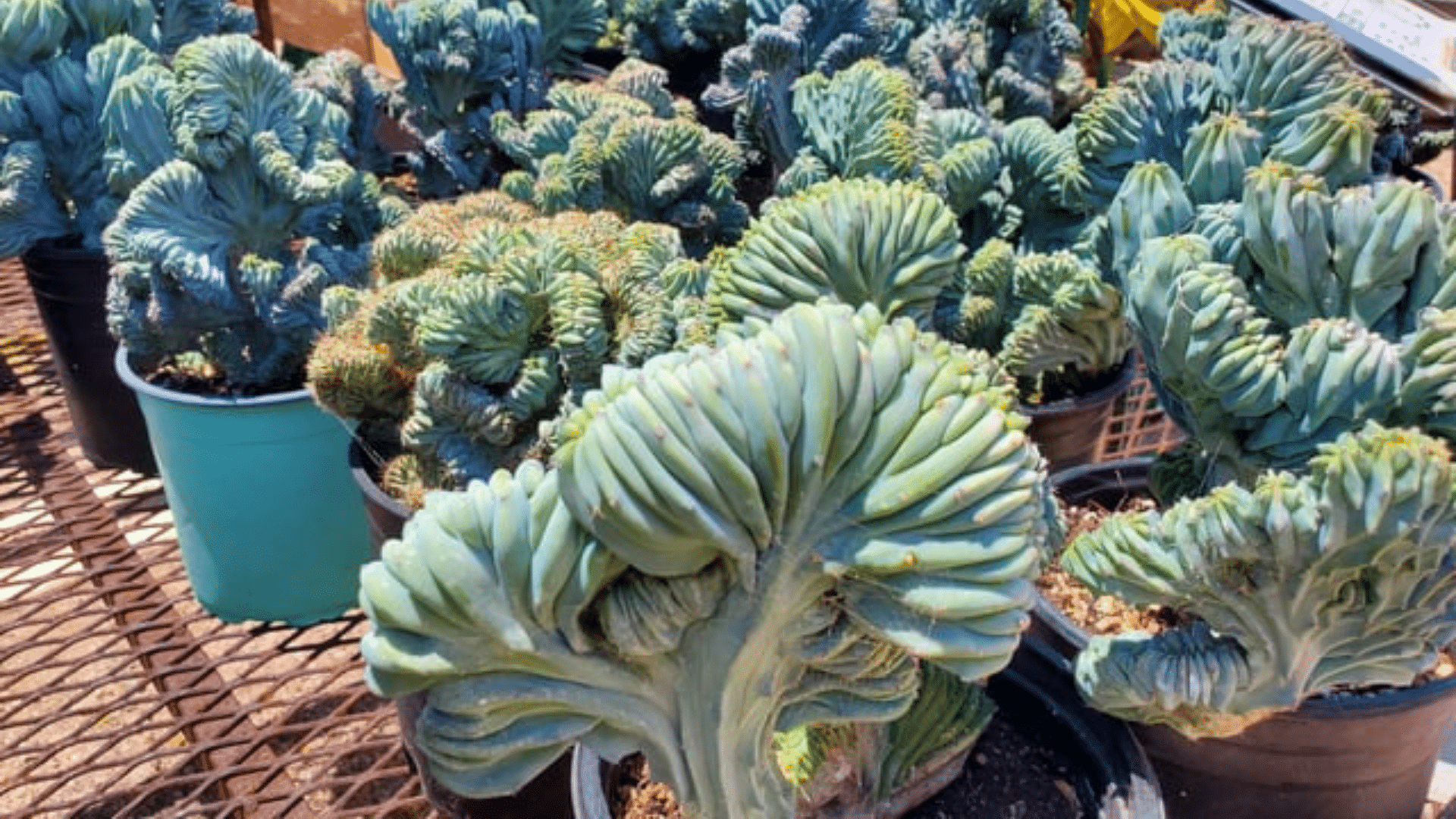
Myrtillocactus geometrizans, also known as the bilberry cactus or blue candle, is native to the arid regions of central and northern Mexico.
This striking, blue-green cactus forms upright, candelabra-like branches and can reach 4–5 meters tall in its natural habitat. It thrives in rocky, well-draining soils and prefers warm temperatures between 18 °C and 30°C, but must be protected from frost and kept above 5°C.
Myrtillocactus geometrizans grows rapidly for a cactus, produces edible dark purple fruits, and requires full sun and minimal watering to flourish
5. Candelabra Cactus (Myrtillocactus Cochal)
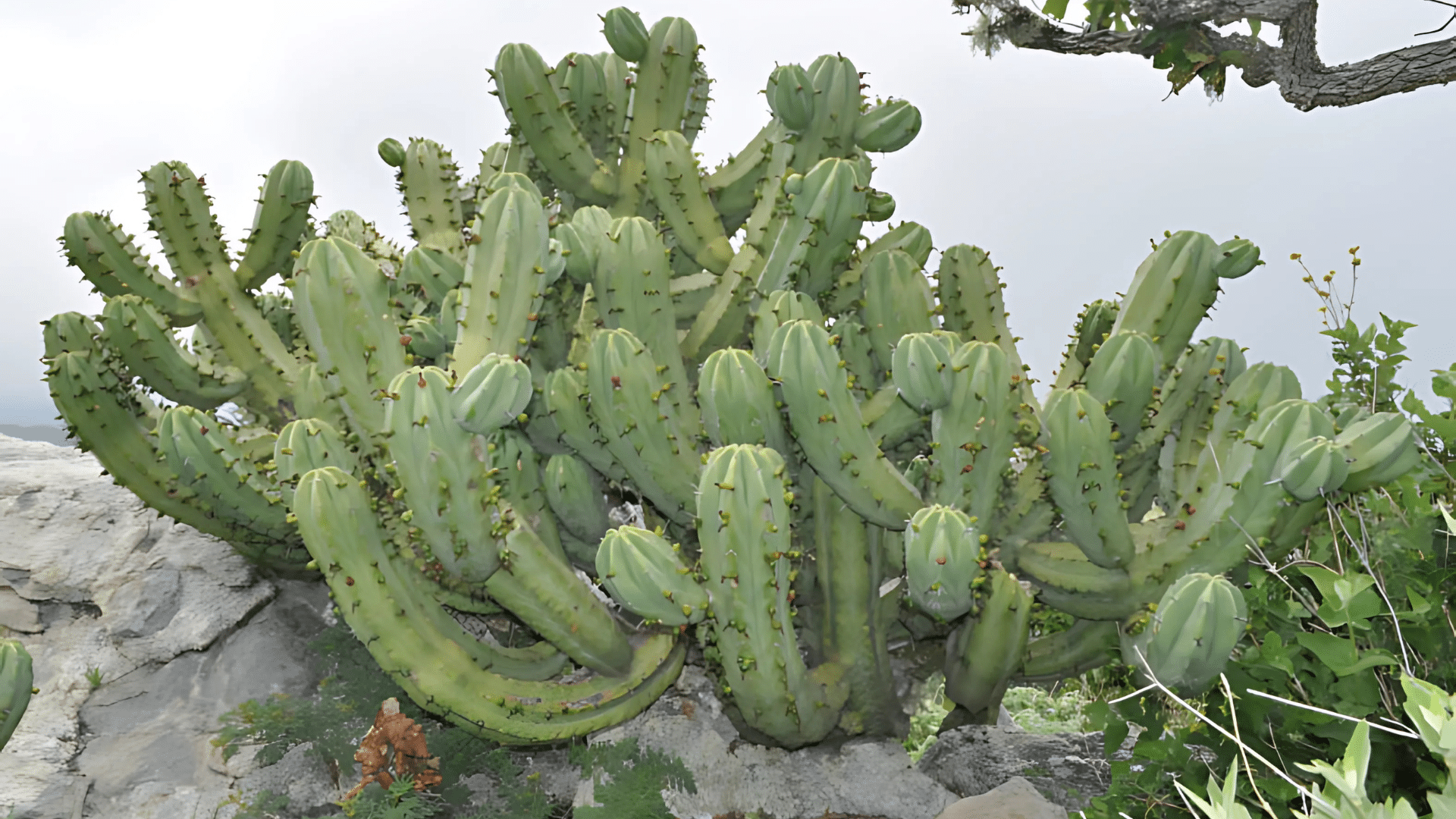
The Candelabra Cactus (Myrtillocactus cochal) is a tall, columnar cactus native to arid regions of Mexico, especially the Baja California peninsula. It can reach up to 10 meters in height and forms dense clusters of blue-green stems covered in spines.
This species thrives in rocky, well-drained soils and full sun, showing strong drought tolerance but sensitivity to frost and freezing temperatures.
The cactus produces small, fragrant white flowers and sweet, edible purple berries, making it valued for both ornamental use and fruit production.
6. Cardón (Pachycereus pringlei)
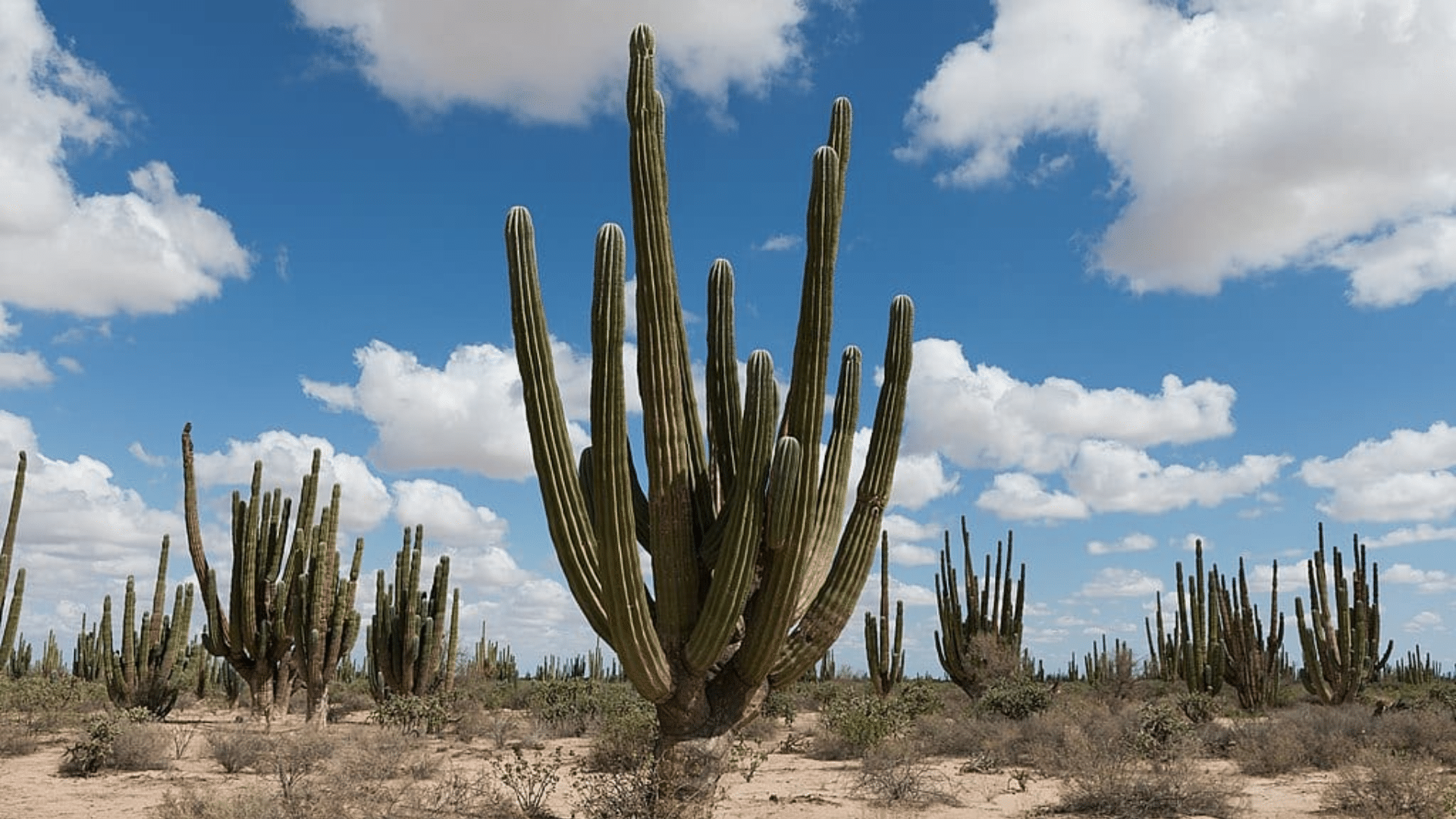
The Cardón (Pachycereus pringlei) is the largest cactus species in the world, native to northwestern Mexico, particularly the Sonoran Desert.
It can reach towering heights of up to 60 feet, with a thick trunk up to 3 feet wide and multiple columnar branches.
Cardón thrives in hot, arid environments with full sun and well-draining, sandy or rocky soils, showing extreme drought tolerance but sensitivity to overwatering and frost.
7. Cereus Peruvianus (Cereus repandus)
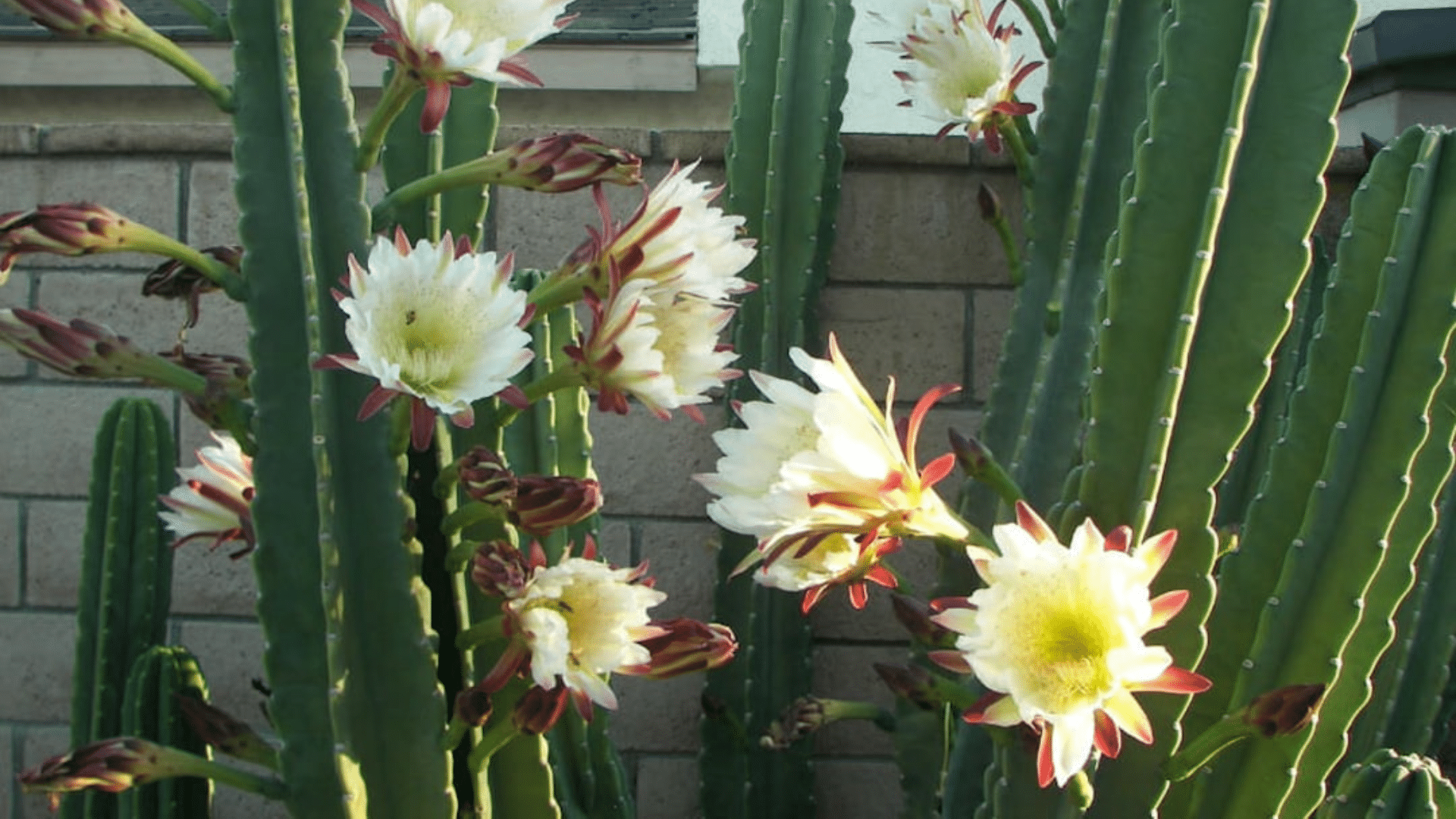
Cereus peruvianus (Cereus repandus), commonly known as the Peruvian apple cactus, is a tall, columnar cactus native to South America, especially Argentina, Uruguay, and Brazil.
It can reach up to 33 feet in height and features blue-green stems with prominent ribs and occasional spines. This species thrives in hot, dry climates and is hardy in USDA zones 9–11, tolerating brief drops to 20–25°F but not prolonged frost.
It prefers full sun, well-draining soil, and regular watering during summer, producing large, nocturnal white flowers and sweet, edible fruits known as Peruvian apples
8. African Milk Tree (Euphorbia Trigona)
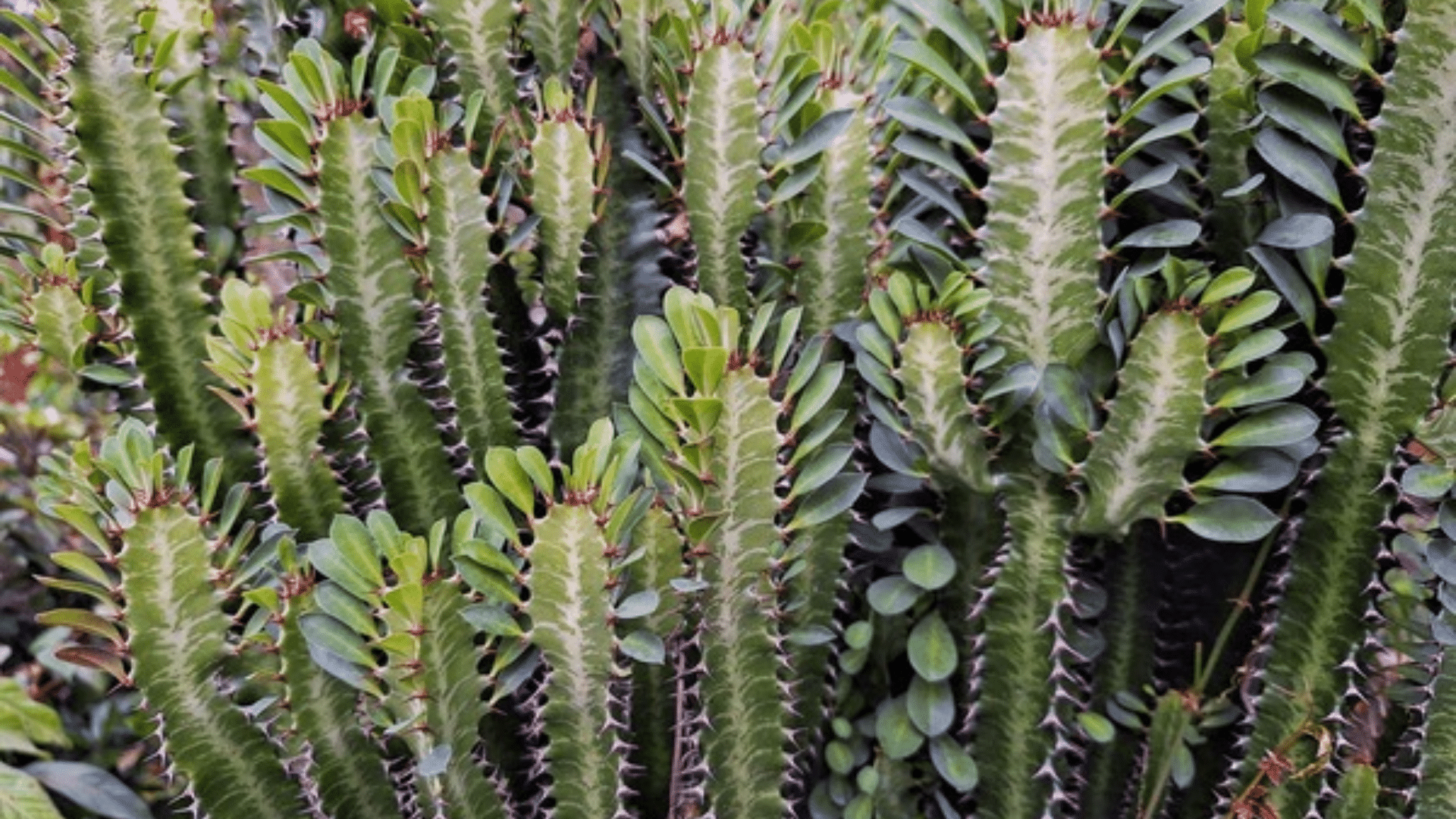
The African Milk Tree (Euphorbia trigona) is a striking, upright succulent native to central Africa, particularly Angola, Gabon, and Congo.
It features tall, three- to four-sided columnar stems with short, paired spines and small, oval leaves that grow along the ridges. Mature plants can reach 6–12 feet tall and develop dense, branching clusters.
Well adapted to hot, arid climates, it thrives in full sun and well-drained soil, tolerating drought but not frost. Its milky sap is toxic and can irritate skin, so care is needed when handling.
9. Senita Cactus (Pachycereus Schottii)
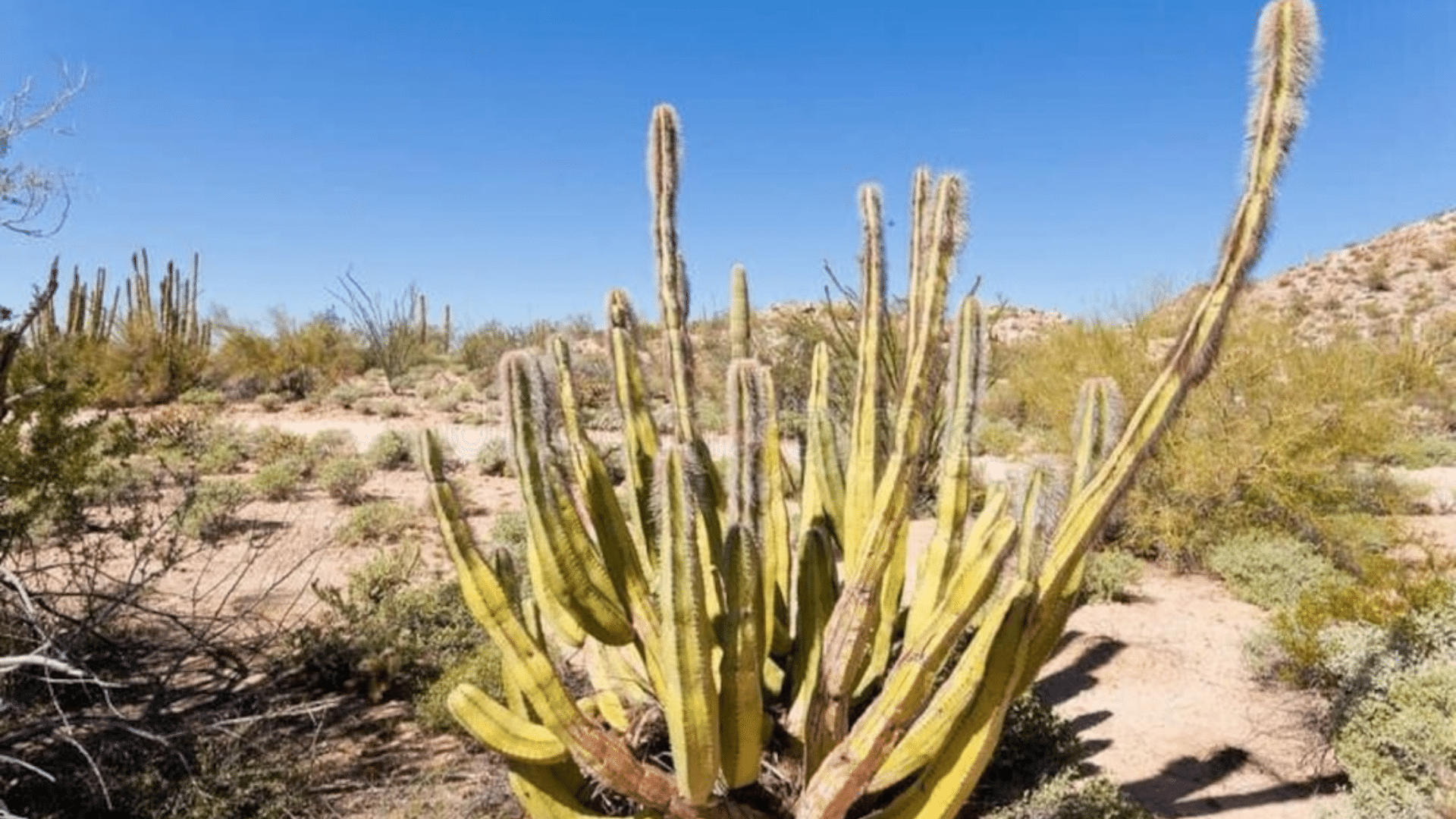
The Senita Cactus (Pachycereus schottii) is a tall, columnar cactus native to the Sonoran Desert of northern Mexico and southern Arizona.
It thrives in arid, rocky terrain with well-drained soils and full sun, tolerating extreme heat but only minimal frost, with a minimum temperature range of 25–30°F.
Senita produces pale pink or white, night-blooming flowers at the tips of older stems, followed by small, sweet, edible red fruits.
10. Totem Pole Cactus (Lophocereus Schottii f. Monstrosus)
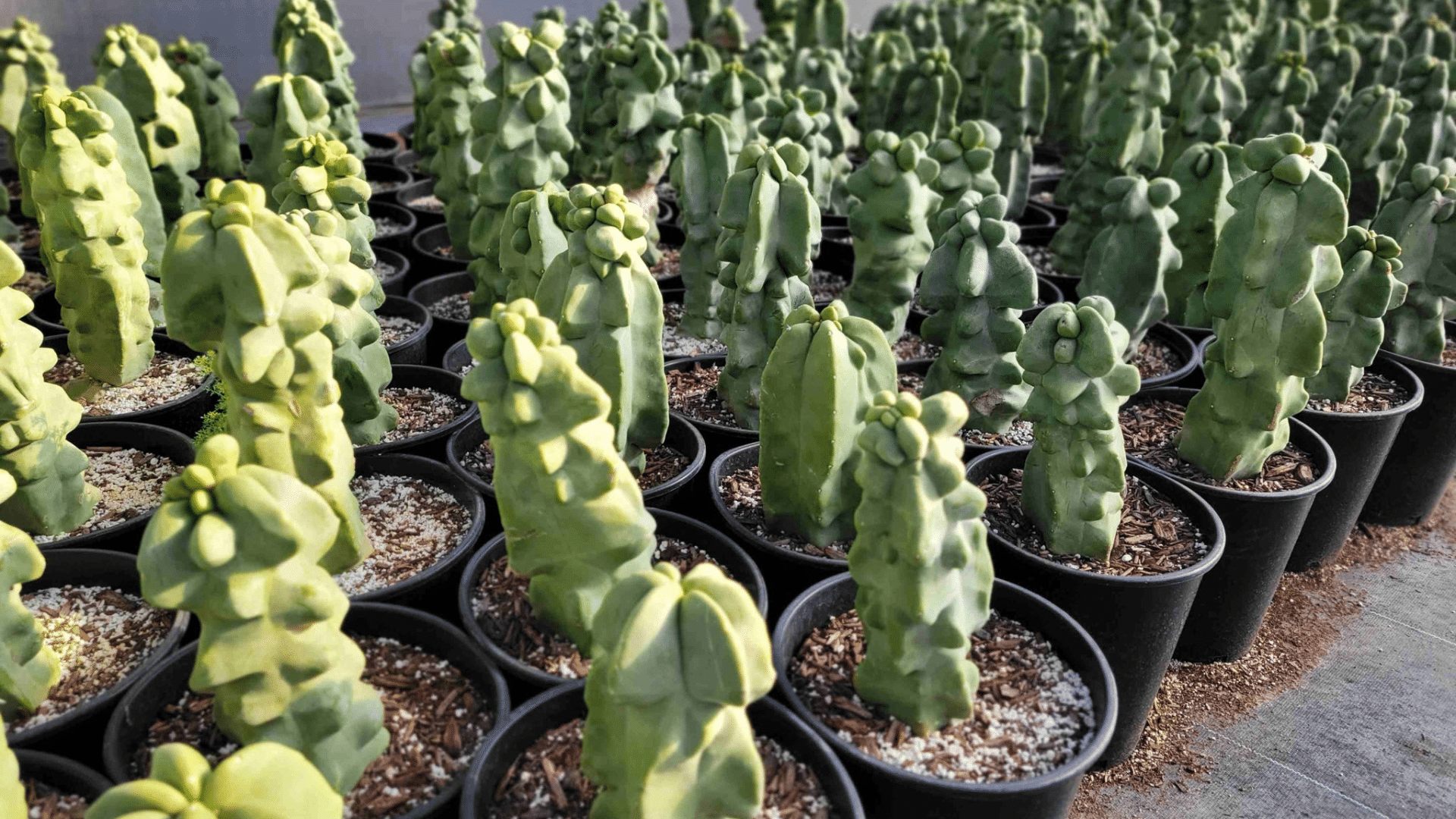
Native to the Sonoran Desert of northwestern Mexico and the southwestern United States, it can reach heights of 10–20 feet outdoors, though it grows more slowly and remains smaller indoors.
This cactus prefers full sun, well-draining soil, and minimal watering, tolerating drought and brief cold snaps down to about 20°F, but not extended frost.
Flowers and fruit are rare, but when present, the cactus produces pale pink blooms and edible red fruit. Its sculptural form makes it a striking choice for xeriscapes, gardens, and container displays.
11. Old Man Cactus (Cephalocereus Senilis)
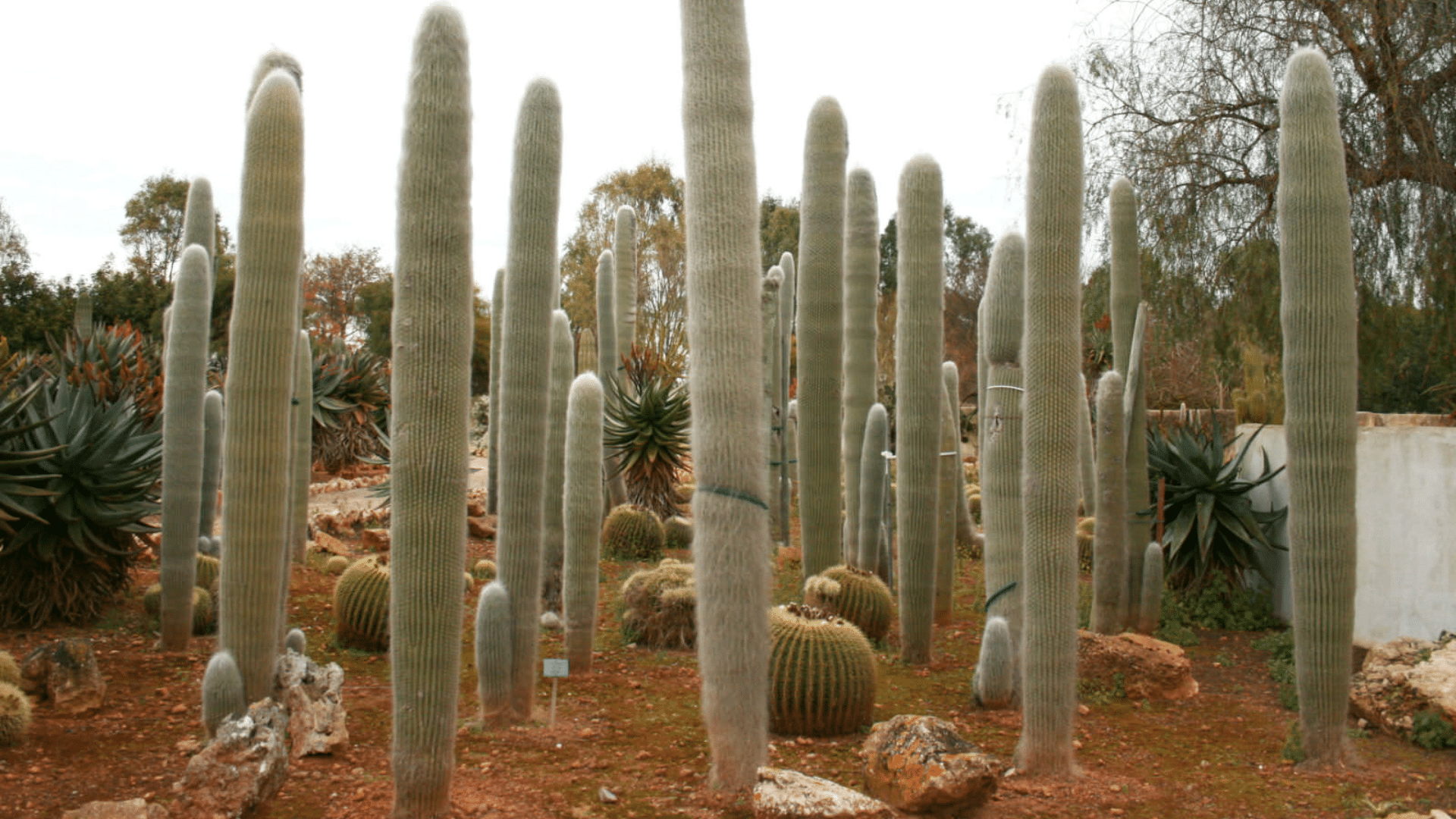
This tall, columnar cactus is native to central Mexico, easily recognized by its dense covering of long, white, hair-like spines that resemble an old man’s beard. In its natural habitat, it can reach heights of 5 to 15 meters (16 to 49 feet) and thrives in arid, rocky environments with well-drained soil and full sun.
The shaggy white hairs protect the plant from intense sun and cold, while sharp yellow spines are hidden beneath.
It is slow-growing, blooms with nocturnal flowers after 10–20 years, and is a popular ornamental cactus for its unique appearance.
12. Queen of the Night (Peniocereus Greggii)
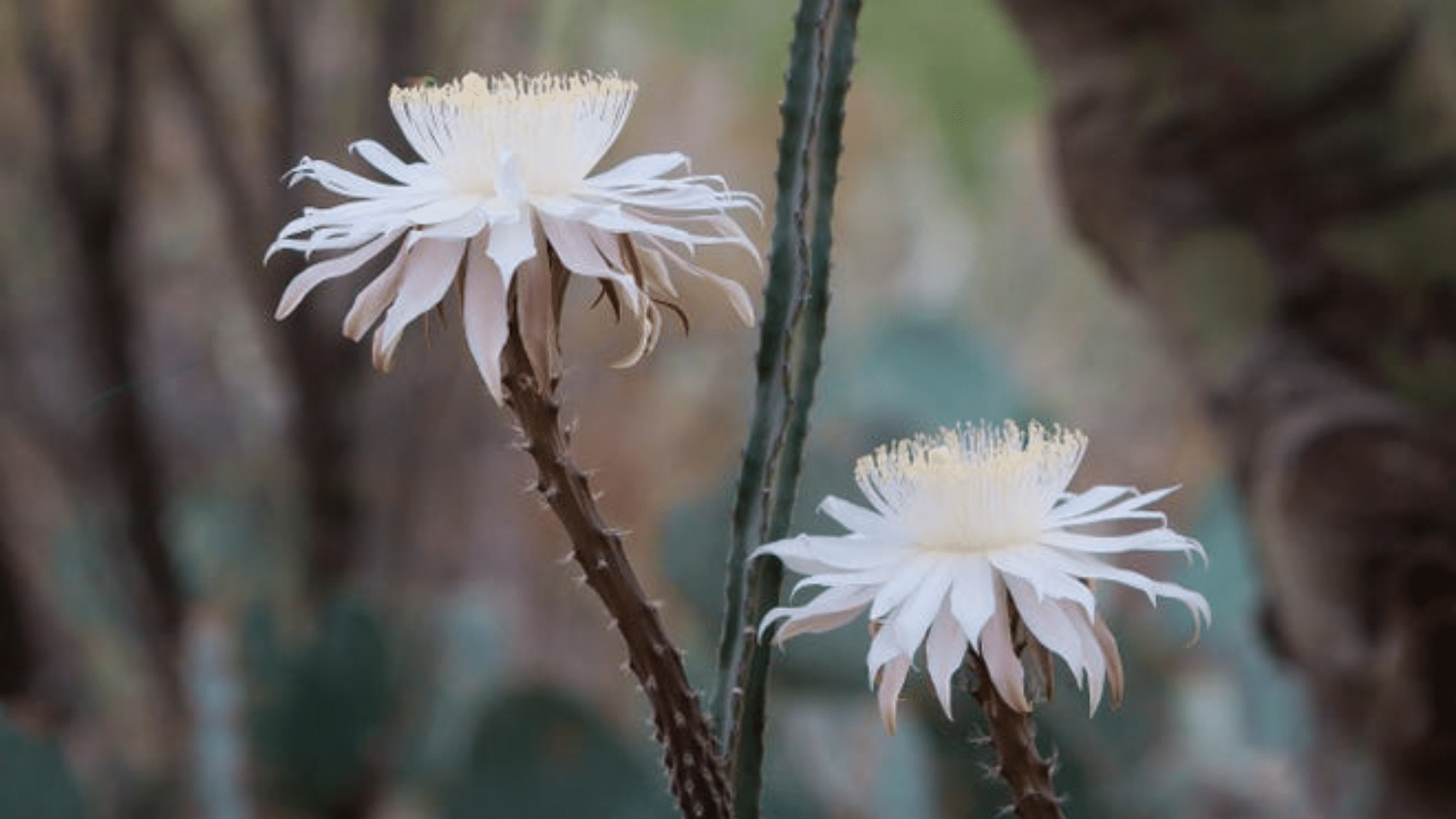
It is a remarkable, night-blooming cactus native to the deserts of Arizona, Texas, and northern Mexico. For most of the year, it appears as a bundle of thin, gray stems resembling dead twigs, often hidden beneath desert shrubs for protection.
Its most striking feature is its large, fragrant white flowers, which bloom only once a year for a single night in early summer, attracting hawk moths for pollination.
A large, tuberous root nourishes the plant and thrives in sandy, well-drained soils with full sun to partial shade, tolerating extreme drought but minimal frost.
13. Prickly Pear (Opuntia ficus-indica and other Opuntia spp.)
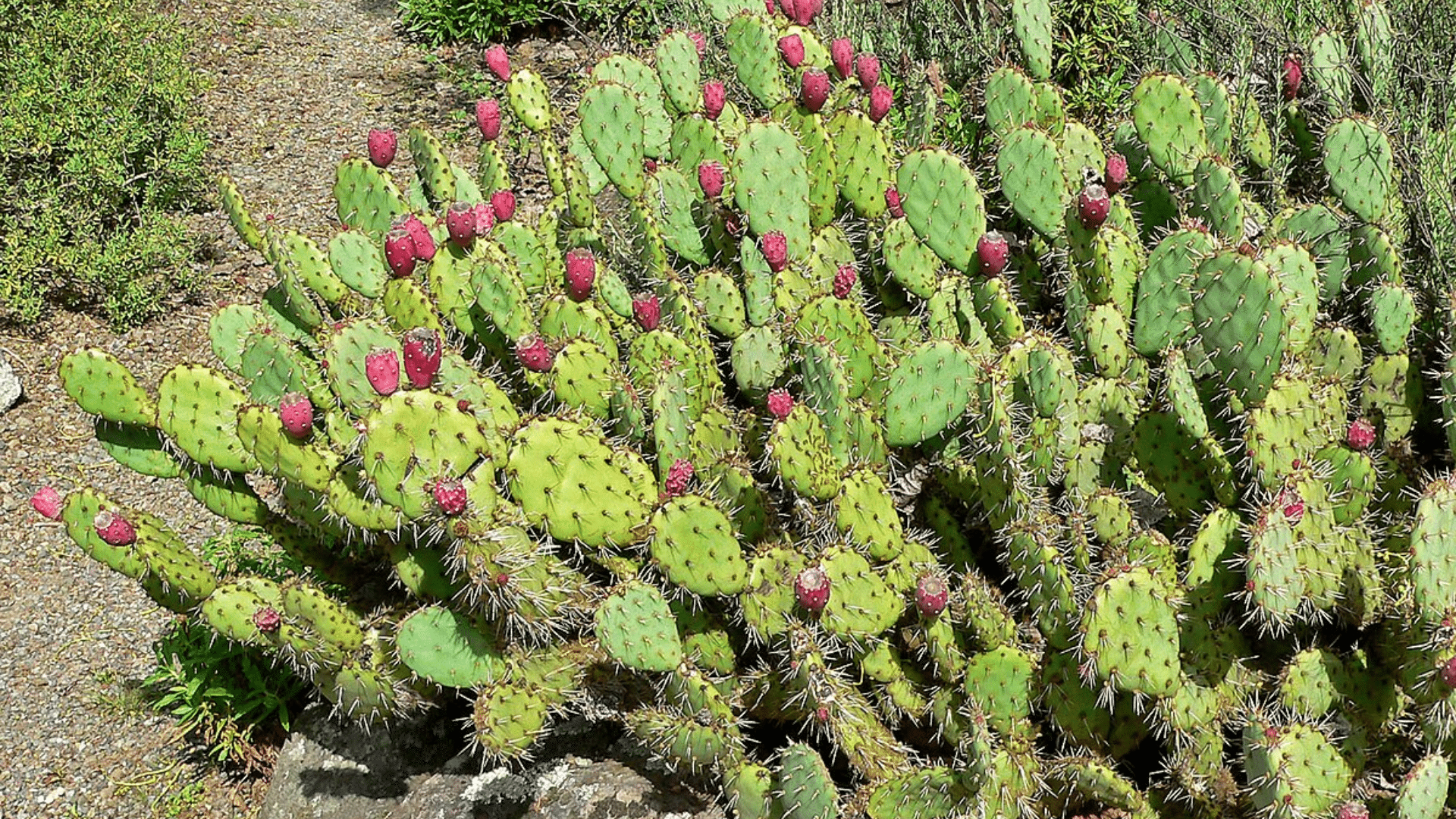
This hardy cactus is a large, segmented cactus native to Mexico but now widespread in arid and semi-arid regions worldwide.
It typically grows as a shrub or small tree up to 5 meters tall, with flat, rounded pads and showy yellow or orange flowers. Prickly pears thrive in areas with mild winters, prolonged dry spells, and hot summers, preferring well-drained sandy or rocky soils and annual rainfall of 200–500 mm.
They are sensitive to prolonged frost and waterlogging, making them best suited to dry, warm climates
14. Golden Barrel Cactus (Echinocactus Grusonii)
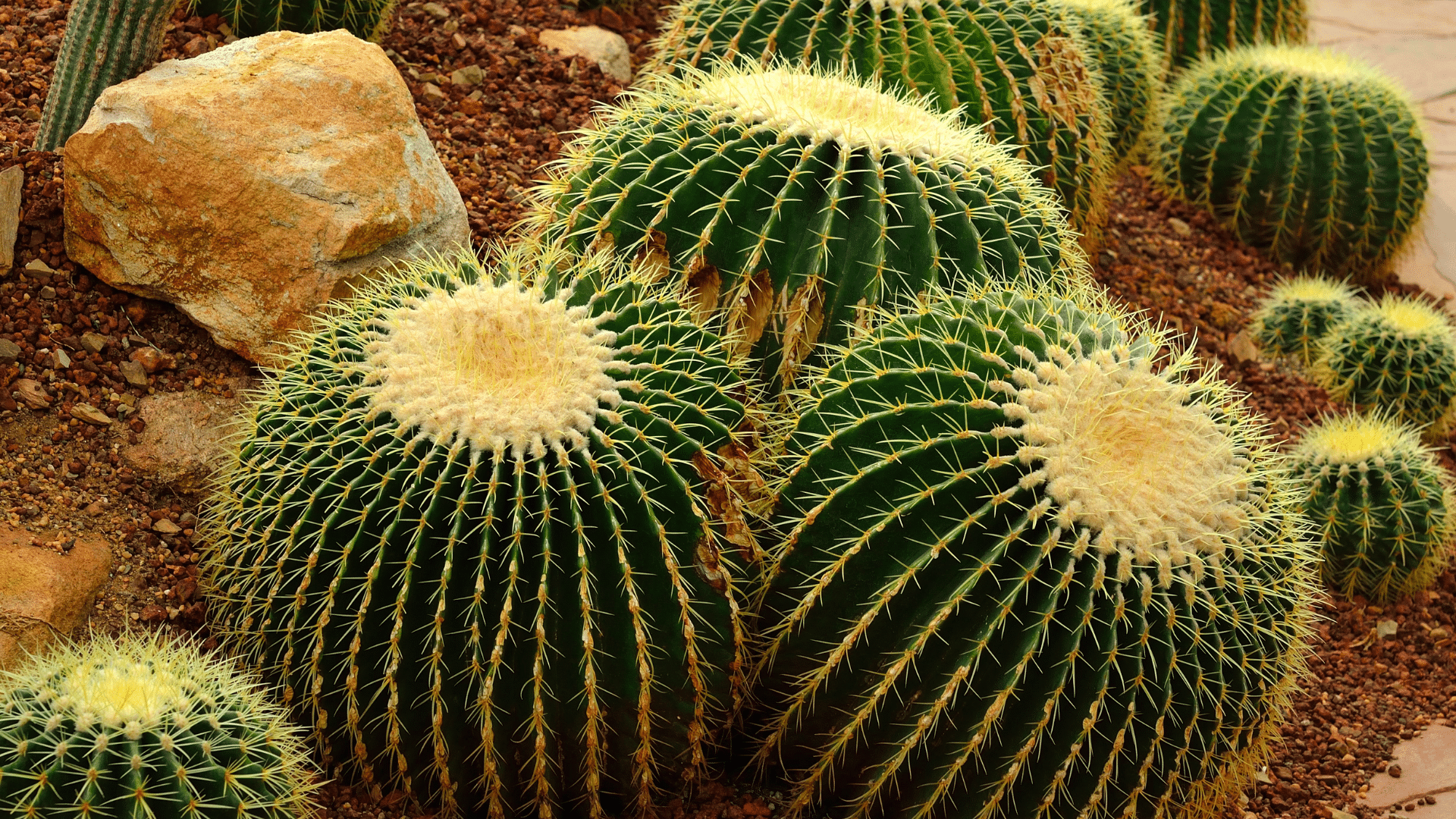
This cactus is a striking, globe-shaped cactus native to central Mexico, often prized for its bold form and golden spines. It thrives in full sun and requires well-draining, sandy or gritty soil to prevent root rot and prefers warm, dry conditions and can tolerate temperatures as low as 50°F, but is not frost-hardy.
Watering should be infrequent, allowing the soil to dry completely between waterings, especially in winter when the plant goes dormant.
The golden barrel cactus is drought-tolerant and best suited to arid, low-humidity environments.
15. Fishhook Barrel Cactus (Ferocactus Wislizeni)
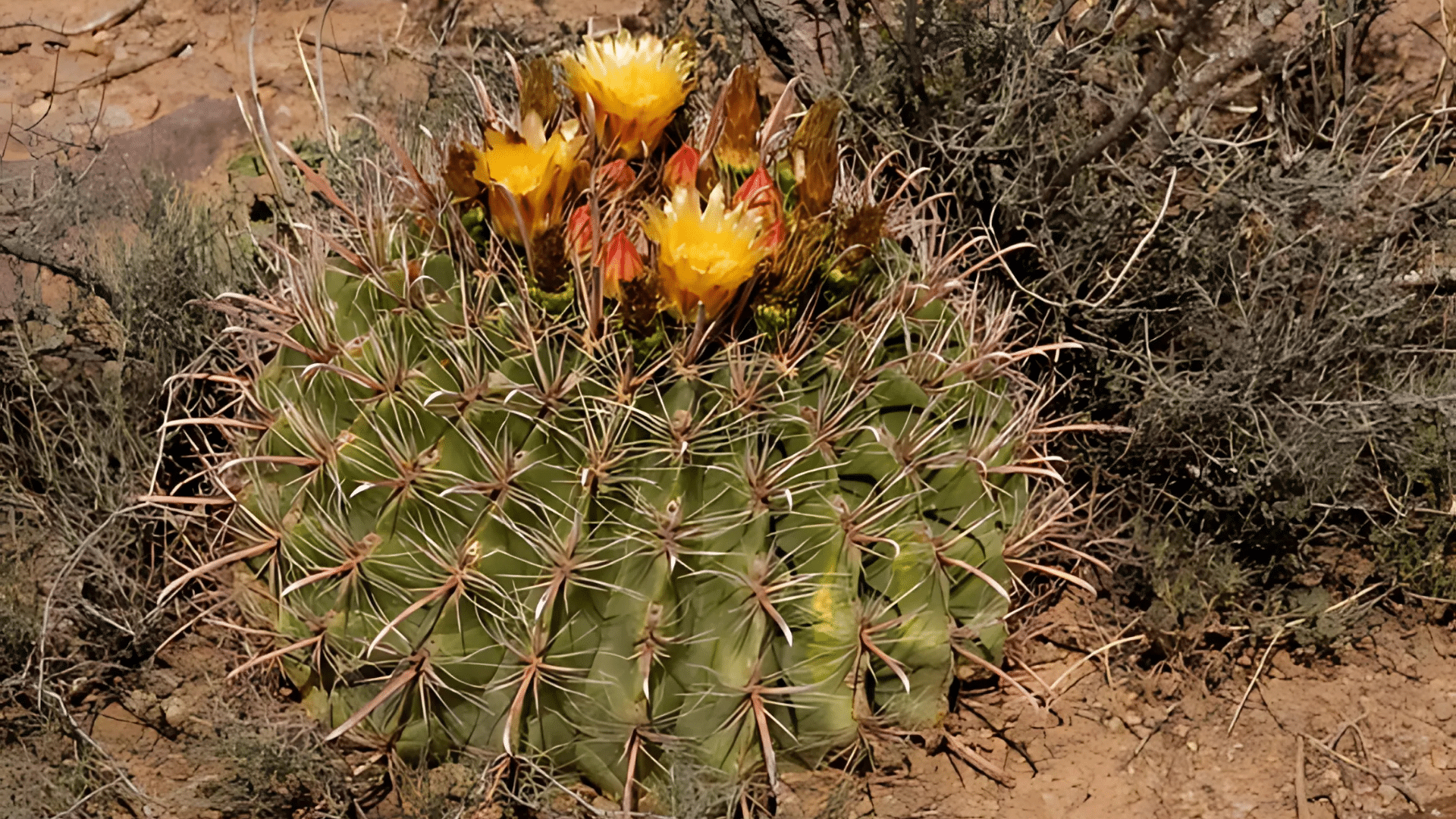
This is a robust, barrel-shaped or cylindrical cactus native to the southwestern United States and northern Mexico. It typically grows 3–6 feet tall and up to 3 feet wide, though some specimens can reach 10 feet.
Its thick, ribbed stems are covered with distinctive hooked spines, giving the cactus its common name. This species thrives in full sun and well-drained, sandy or rocky soils, showing strong drought tolerance and low maintenance needs.
Bright yellow, orange, or red flowers bloom in summer, followed by fleshy, pineapple-shaped fruits that persist atop the cactus into winter
16. Strawberry Hedgehog Cactus (Echinocereus Engelmannii)
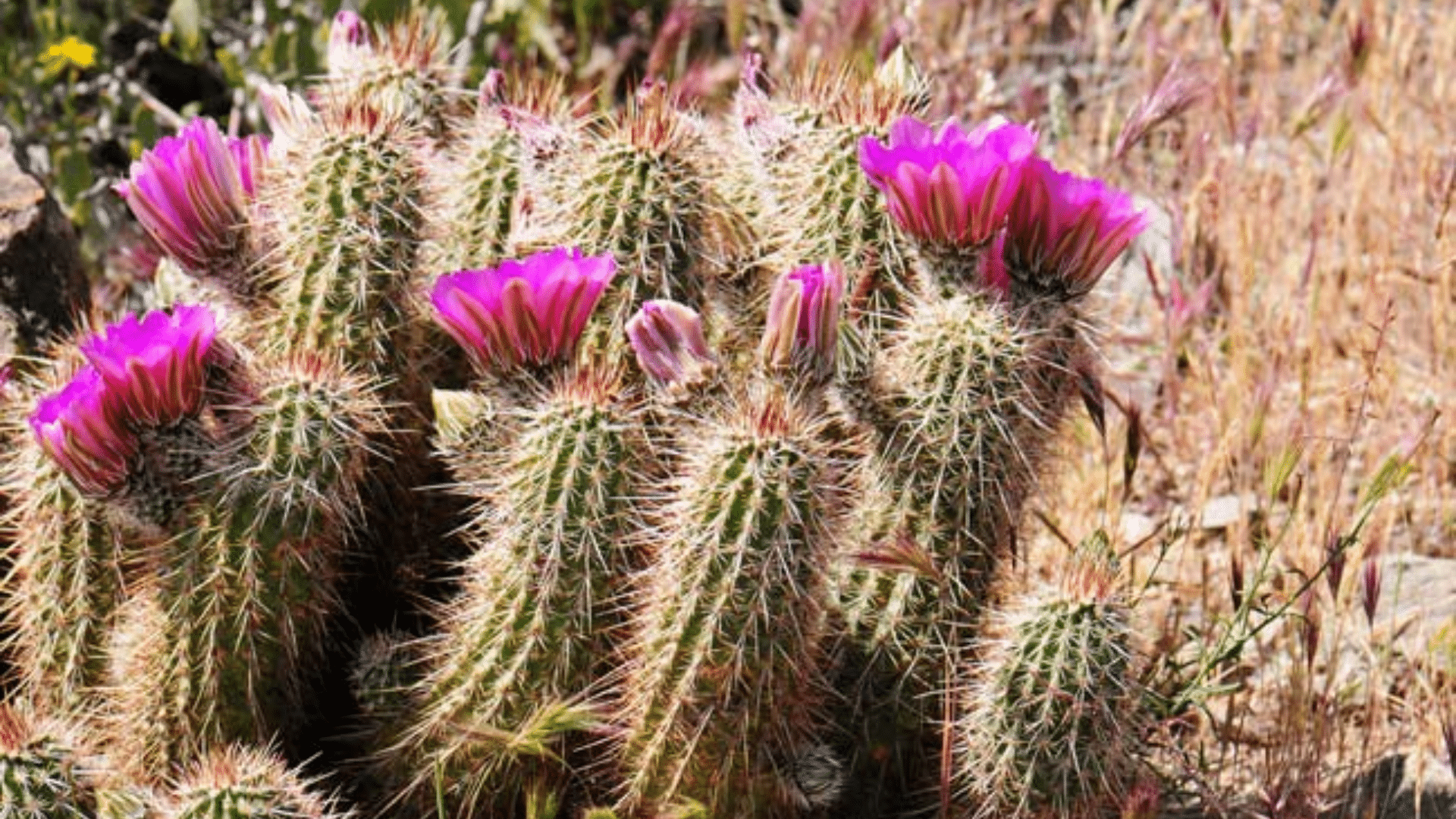
This is a small, clumping cactus native to the deserts of the southwestern United States and northern Mexico. It typically grows 4 to 12 inches tall and forms dense clusters of upright, spiny stems that resemble hedgehogs.
This cactus thrives in full sun and well-draining, sandy or rocky soil, requiring at least six hours of direct sunlight daily and minimal watering. It is essential to allow the soil to dry completely between waterings to prevent root rot.
This cactus is drought-tolerant, prefers temperatures above 50°F, and is valued for both its ornamental blooms and delicious fruit.
17. Claret Cup Cactus (Echinocereus Triglochidiatus)

The Claret Cup Cactus (Echinocereus triglochidiatus) is a low-growing, clumping cactus native to the southwestern United States, including states like Arizona, New Mexico, and Colorado. It typically reaches 1 to 2 feet in height and spread, forming dense mounds of cylindrical stems covered in sharp spines.
This cactus thrives in full sun and well-drained sandy or rocky soils, requiring very little water and showing strong drought tolerance.
In late spring, it produces a stunning display of bright red to orange-red flowers that often cover the entire plant, attracting bees and hummingbirds.
18. The Beehive Cactus (Coryphantha spp.)
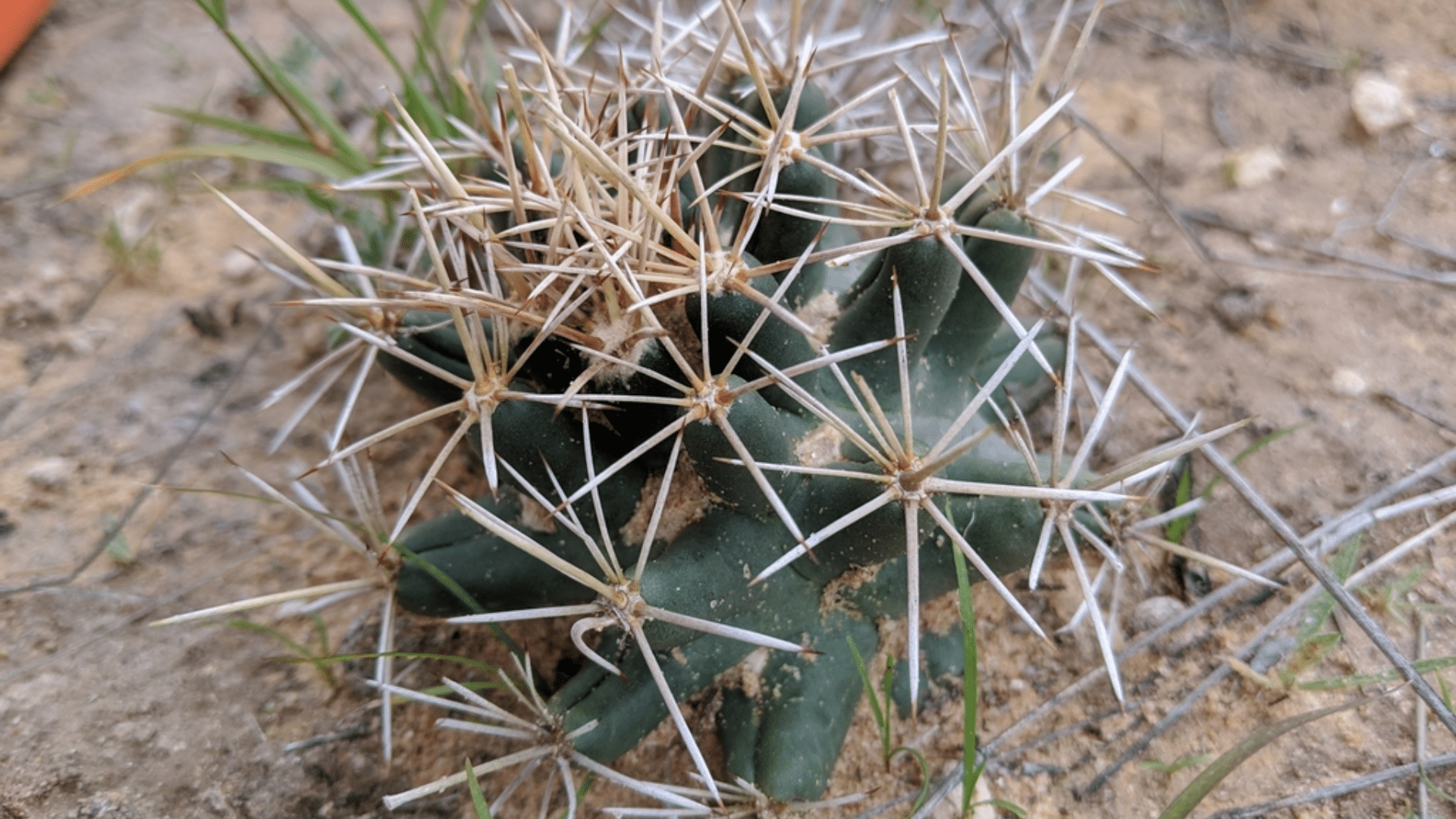
The Beehive Cactus (Coryphantha spp.) is a genus of small to medium-sized, globular or columnar cacti native to arid regions of Central America, Mexico, and the southwestern United States.
Beehive cacti produce large, showy flowers in shades of lavender, pink, yellow, orange, or white at the apex of the plant, and their fruits are edible berries that can be green, red, or yellowish.
They thrive in well-draining, sandy or rocky soils and full sun, requiring minimal water and tolerating drought but not prolonged frost.
19. Mammillaria (Mammillaria spp.)
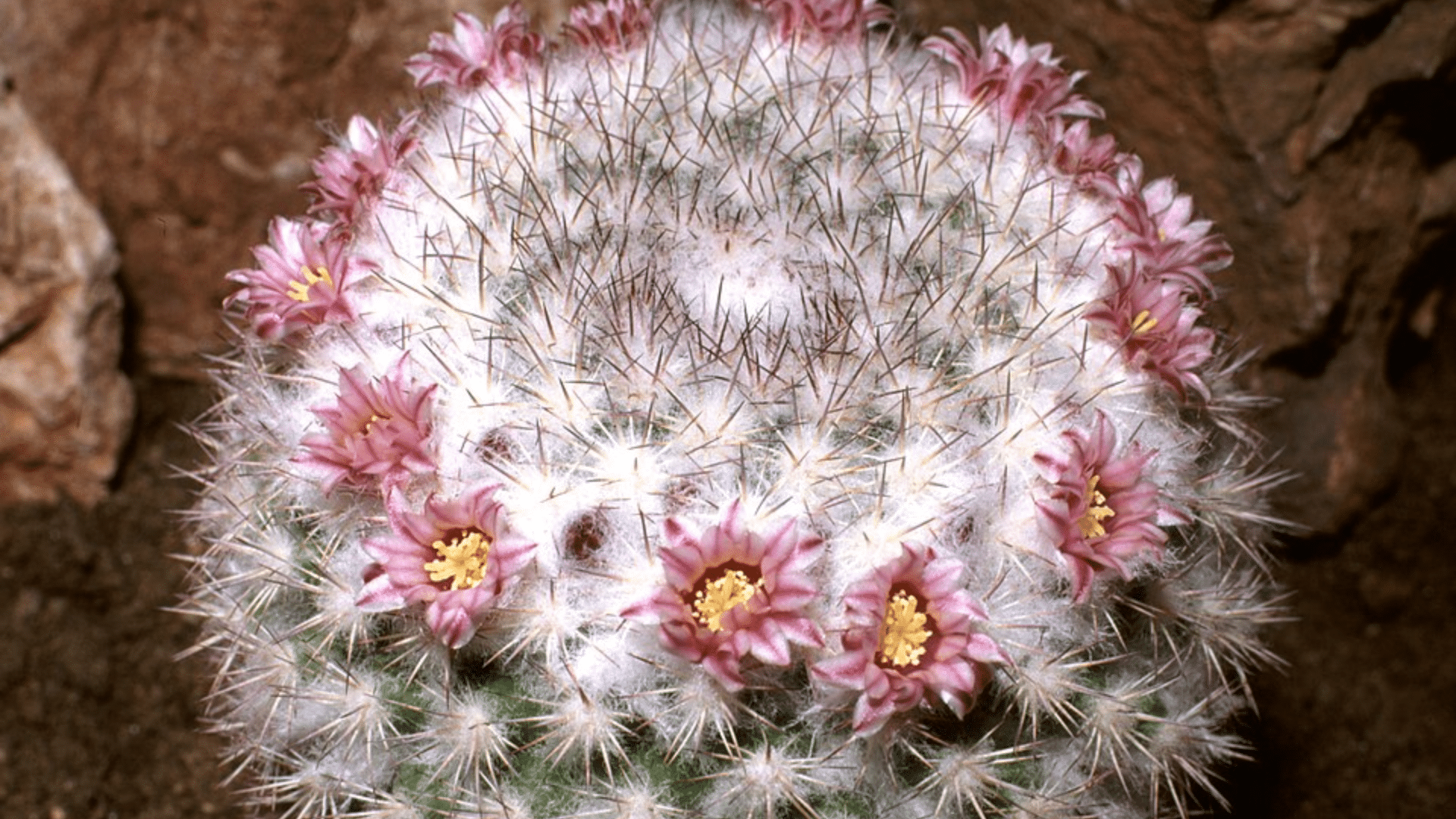
The Mammillaria genus includes over 200 small cacti species native to Mexico and the southwestern U.S. They feature dense, spiral-arranged tubercles topped with varied spines.
Typically 1 to 12 inches tall, their funnel-shaped flowers bloom in spring or summer around the crown in colors like white, pink, and yellow.
These drought-tolerant, sun-loving cacti thrive in well-draining soil, are frost-sensitive, and valued for easy care and ornamental appeal.
20. Cholla (Cylindropuntia spp.)
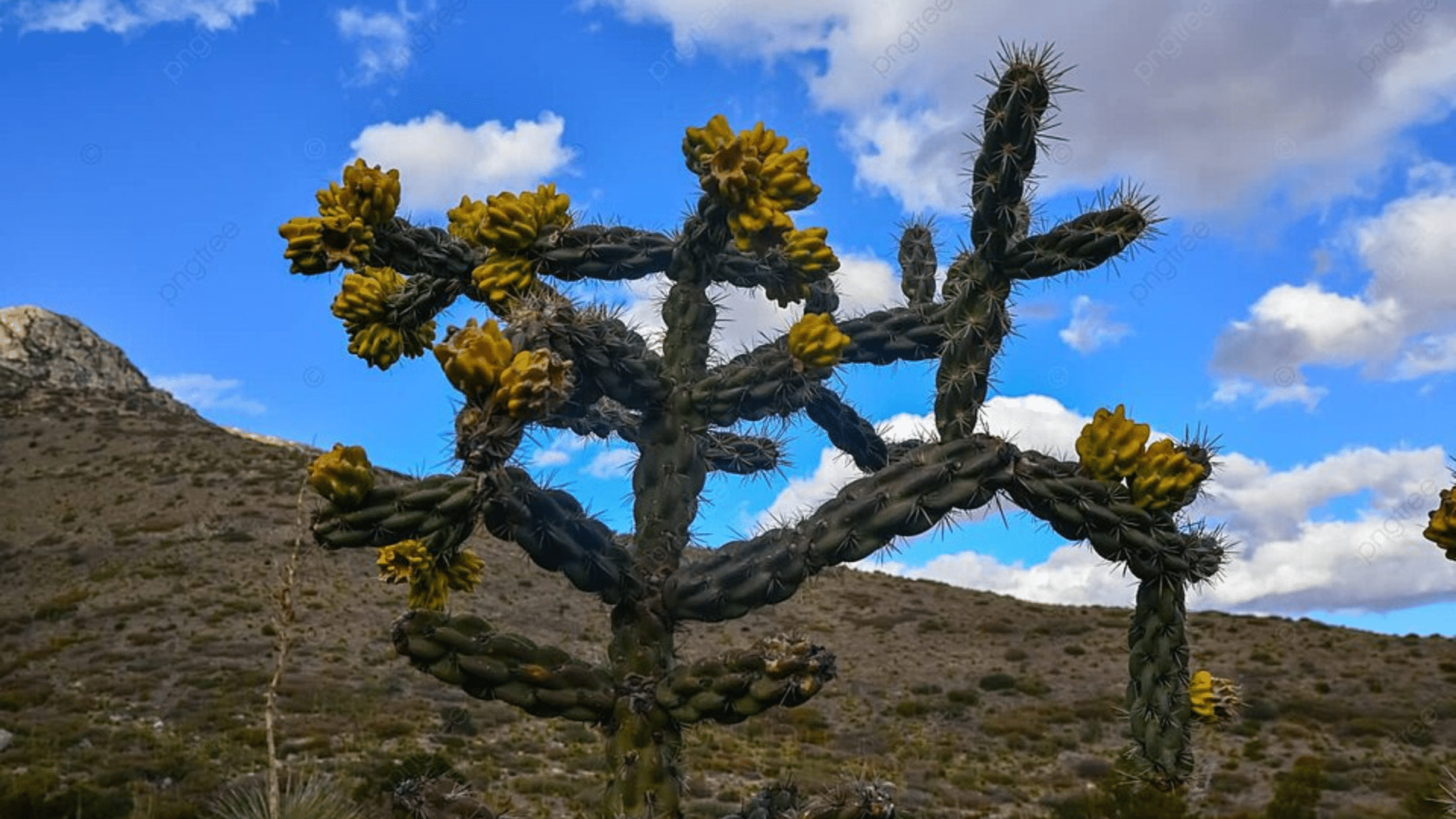
The Cholla (Cylindropuntia spp.) is a genus of about 35 species of cacti native to North and South America and the West Indies.
These cacti are recognized by their segmented, cylindrical stems and barbed spines that easily attach to skin, fur, or clothing, making them notorious in desert environments.
Chollas range in size from low, branching shrubs to small trees up to 10 feet tall. They thrive in full sun and well-drained, sandy or rocky soils, and are highly drought-tolerant, making them well-suited to harsh desert landscapes.
21. Star Cactus (Astrophytum Asterias)
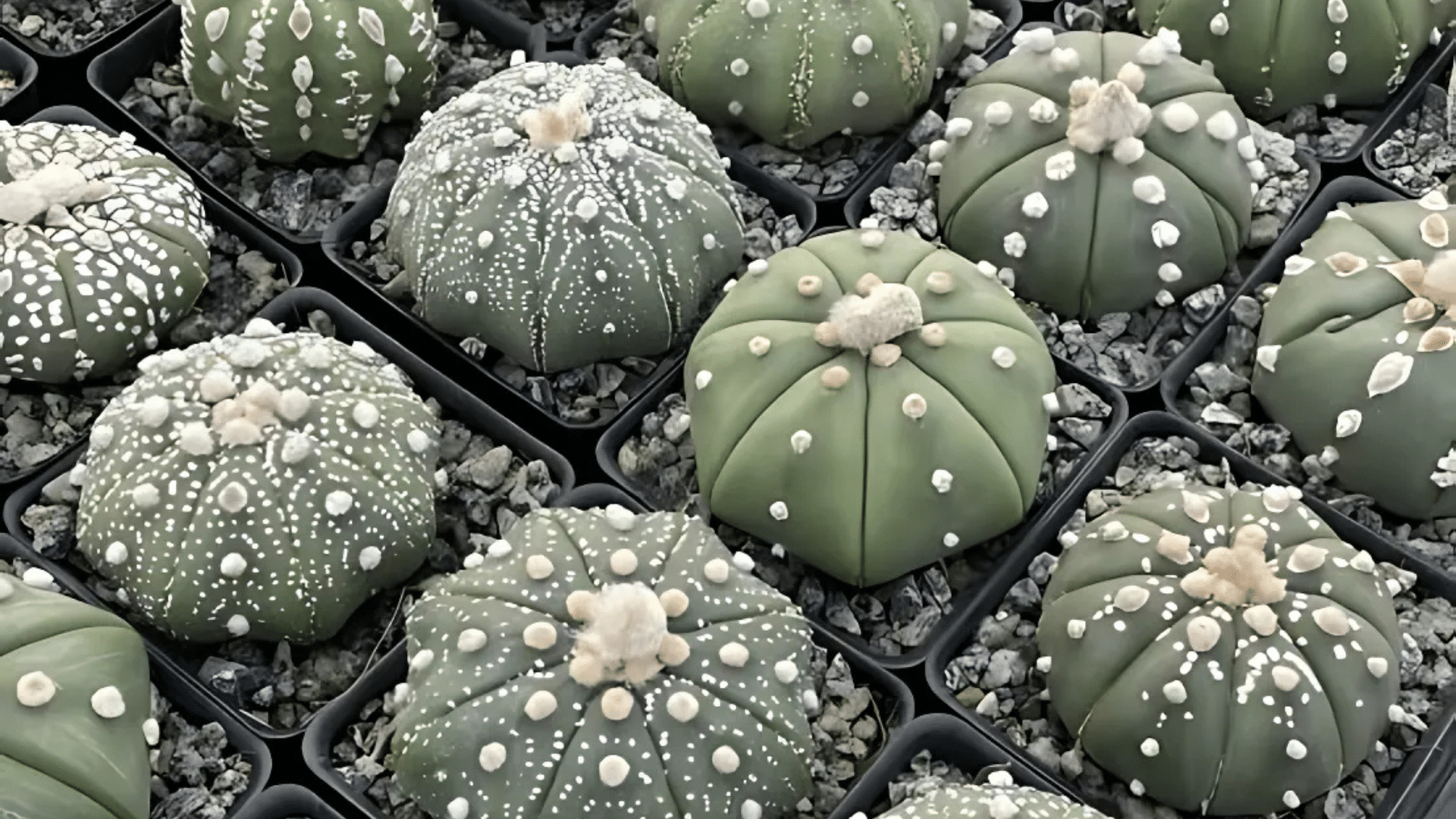
The Star Cactus (Astrophytum asterias) is a small, spineless cactus native to southern Texas and northeastern Mexico, recognized for its flat, disc-shaped body divided into 7–10 ribs and speckled with white scales.
Typically measuring 2–6 inches (5–15 cm) across and up to 2.7 inches (7 cm) tall, it produces striking yellow flowers with orange-red centers in spring and summer.
This cactus thrives in full sun, well-draining sandy soil, and warm, dry conditions, tolerating brief drops to 20°F but preferring temperatures between 65–80°F.
22. Rat Tail Cactus (Aporocactus Flagelliformis)
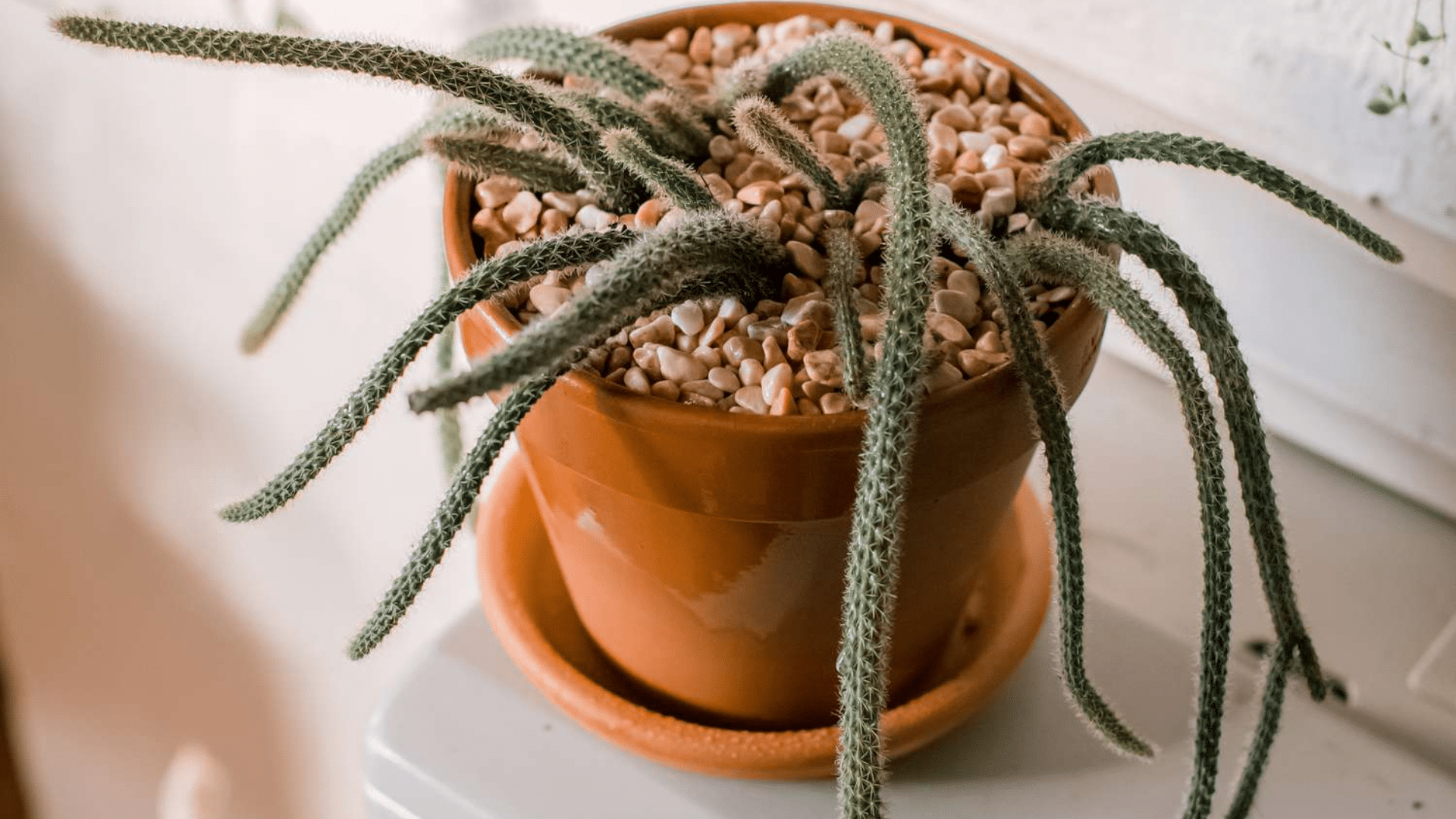
The Rat Tail Cactus (Aporocactus flagelliformis) is a striking succulent native to Mexico, known for its long, trailing stems that can grow several feet in length, making it ideal for hanging baskets.
It thrives in bright, indirect light and well-draining, sandy soil, preferring moderate temperatures and protection from frost.
Watering should be infrequent, allowing the soil to dry out almost completely between waterings, especially during its winter dormancy. In spring and summer, it may produce tubular pink or red flowers along its stems, adding to its ornamental appeal.
Styling Ideas for Outdoor Cactus in your Garden
- Use flowing, curved beds instead of straight lines for a more natural look in desert gardens, integrating rock gardens with smaller cacti nestled between boulders for visual interest.
- Group plants by water needs for efficient xeriscaping, and use gravel mulch throughout to unify the design and help with drainage.
- Pair cacti with agave for bold texture, colorful sedum for ground cover, ornamental grasses like fountain grass for movement, yucca for height, and trailing portulaca to fill gaps with bright blooms.
- Incorporate weathered driftwood as natural sculptures, smooth river rocks for pathways, mulch, and large ceramic or terracotta pots to create focal points and add character to the space.
- Build terraced slopes with retaining stones and vertical garden walls with planting pockets to maximize space and show off plant shapes at different heights.
- Design themed sections (such as a golden-spined area or a flowering corner) and mix early and late bloomers to keep the garden visually appealing and in flower throughout the growing season.
Conclusion
Growing outdoor cactus has brought me so much satisfaction over the years. These hardy plants reward you with stunning shapes, surprising flowers, and almost zero maintenance once established.
Start with just one or two varieties that suit your climate. Mix different heights and textures, maybe a tall columnar type with some round barrel cactus. Don’t be afraid to experiment with colors and placement.
Trust me, once you see how these spiky beauties thrive outdoors, you’ll want to add more.


